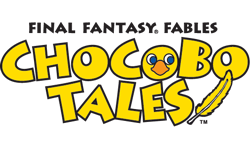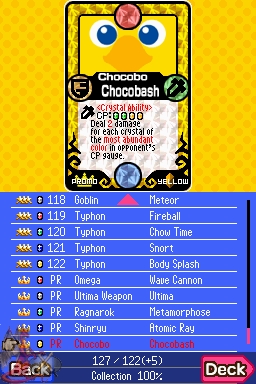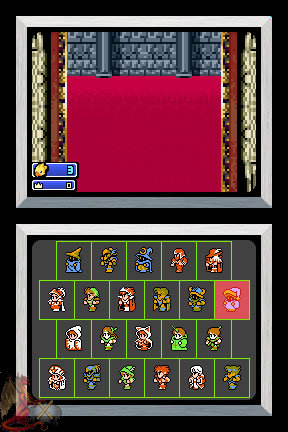|
|

|
BATTLE SYSTEM
|

|
INTERACTION
|

|
ORIGINALITY
|

|
STORY
|

|
MUSIC & SOUND
|

|
VISUALS
|

|
CHALLENGE
|
Too Easy
|
Easy
|
5 - 15 Hours
|
|
OVERALL
3.0/5
|
Rating definitions
|
|
|
Is a picture really worth a thousand words? Not when picture books come alive and Chocobo must enter the world of fiction in order to save his friends. Join the feathered (and non feathered) crew in Final Fantasy themed fairy tales, as they try to overcome a demon locked away in a book centuries before. Starring in his own title once again, Final Fantasy Fables: Chocobo Tales allows the player to take the role of the cute, yellow Chocobo fans have come to know and love. Though the game is too easy for its own good and the story falls laughably short, there is still something oddly addictive and appealing about this DS title.
There is no combat in Chocobo Tales as there is in traditional FF games. Instead, Chocobo must succesfully complete tasks inside books in a variety of small games: swimming around obstacles, spotting a flaming chocobo, dodging Ramuh's lightning, and several other fast paced tasks. Games are for the most part timed, so sharp eyes and good reflexes are a must in order to succeed. Each book has five levels of difficulty and eight different secrets to unlock. Unlocking secrets in a book results in one of three actions. Each book has three prologues, and once written they affect the real world, such as a boulder moving, or Carbuncle the Lucky appearing. Alternatively, one of Chocobo's friends is rescued (25 friends in total). Lastly, the player may be rewarded with a pop-up card.
Pop-up cards are where the head to head battles blossom. Players build decks with a selection of more than 100 cards in order to defeat opponents and continue with the storyline. Cards can be several colors: yellow, blue, red, green, and grey (no color). Each card has a circle on each of the four sides. These circles may contain a sword, a shield, or be blank. At the beginning of a turn, each player chooses a card. The player who chooses first then plays first. If a card has a sword, it will attempt to attack. Circles from the same side match up, and one of three outcomes will occur: if the opponent's card has a blank, the attack succeeds; if the opposing side has a sword, half damage is dealt; lastly, if the opposing side has a shield, the attack will be fully blocked. A card will have at least one spot with a shield or sword, though never more than one sword. Some cards even have all four slots filled with shields. Many cards include a special trigger ability, which vary depending on the card. Some examples include doing double damage when an opponent's card is a certain color, counterattacking after blocking, and inflicting a status effect after a successful attack. Status effects double the damage that color card will do next turn, so it is important to stock both offensive and defensive cards in a deck and be prepared to block vicious attacks. At the end of each turn, the color of the card is turned into a crystal which is added to each player's crystal bar, which further affects which cards the player may play. Some cards require a certain number of crystals in order to use their attacks or special abilities. A few cards destroy crystals from the opponent's bar, and some rare cards even change the color of crystals in the player's or opponent's bar. The most powerful cards deal damage based upon the number of crystals in a player's bar and their type. Balacing decks against each new opponent will provide great enjoyment to strategists.
 A Pop-Up Card
A Pop-Up Card
|
|
In addition to the mini-games and pop-up battles, scattered throughout the world are micro-games. These games take about one minute to play each and reward the player with additional pop-up cards. In order to complete a full pop-up card set, the player will need to master all three aspects of the game: mini-games which reside inside each storybook, micro-games as described here, as well as the pop-up battles that occur from time to time throughout the story. This doesn't even touch upon the fact that players can battle each other in multiplayer pop-up battles as well as mini-games via WiFi.
The music will be familiar to anyone who has ever played a Final Fantasy game, as tracks are remixes from previous games; there seems to be very little new music. Whether this is a good or bad point will depend upon the preference of the player. The visuals take the same lighthearted tone as the rest of the game. With predominantly light and splashy colors, they looks simply fantastic. While the graphics are in no way realistic and seeing the human characters walk around is worth a chuckle, the visuals do the job of expressing the variety of emotional and physical reactions that the characters go through as more of the 'sinister' plot is revealed to the participants.
The story, as revealed earlier, is quite silly and irreverent. Though it is lighthearted and on the slim side, it does get the job done and evokes some level of emotion in the player, so it isn't a complete loss. The originality of the story is certainly there, even if it reuses material players have seen over and over in previous FF entries; then again, few games allow the player to hop between pages and act out fairy tales. These fairy tales have been changed slightly from their original themes, although it is pretty simple to pick up on the origin of the story as the titles tend to give it away. What the storybook requires the player to do is also intuitive. The Boy Who Cried Leviathan, for example, includes swimming mini-games.
The game doesn't take much time to complete; a dedicated player could finish the game in as little as five hours if they avoided doing everything except pressing forward with the main storyline. For those wishing to rescue all 25 of Chocobo's companions, to complete their pop-up card collection, and to finish all the mini- and micro-games available both inside and outside books, players will likely need to dedicate a minimum of 15 hours to the game. That being said, while some tasks will be easier to master than others, the game is not terribly difficult and these hours will fly by very quickly. In many ways, the game is actually too easy; until a player defeats a pop-up dueler for the first time, the opponent will play the same cycle of cards with only miniscule variations.
 Oddly Familiar Classes...
Oddly Familiar Classes...
|
|
Menus are simple and accessible with the touch of the screen, in order to access the pop-up cards, save, or exit. Cards can be examined, and decks can be created, edited, and deleted in this fashion. While a player can track their card collection progress, there is no central way to track progression across all the storybooks, which is frustrating. The localization is well done, with a few amusing pop culture references but mostly solid work. While translating the story would have been a breeze, there was much to localize in the form of books, micro-game instructions, and all of the cards. The quality certainly will not wow the player, but everything is comprehensible and no discernable errors are seen in the various cards or stories.
Players looking for a deep, engrossing game simply won't find what they are looking for here; Chocobo Tales takes nothing seriously, least of all itself. As pop-up duel partners remain available to battle once they've been initially defeated, in addition to the fact that mastering the micro-games will take patience and practice, the game has a surprisingly large replay value -- even if the story itself may not be worth replaying. For those that are looking for something different than the usual level grind of a typical RPG, and for those that enjoy strategy, this title is a definite must-have. Those looking for a challenge or a lengthy title will want to seek those aspects elsewhere.
Review Archives
|









